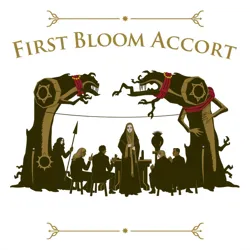First Bloom Accord
The First Bloom Accord was a landmark agreement in the history of the Arborian Epoch, symbolizing a pivotal moment of unity and cooperation among the diverse factions of the Arboreal civilization. Signed approximately 500 years ago, it marked the end of prolonged conflicts and established a framework for peaceful coexistence and collaborative governance among the sentient plants of Verdantia.

Ceremonial depiction of the signing of the First Bloom Accord, symbolizing unity and peace among Arborian factions.
Historical Context
Before the signing of the First Bloom Accord, the Arboreal society was characterized by fractious divisions among various petal factions, each vying for control over vital resources such as sunlight and nutrients. These conflicts threatened the stability and prosperity of the Arboreal civilization, prompting a collective realization of the need for a unified approach to governance and resource management.
The Accord was conceived during the Great Canopy Conference, a gathering of leaders from across the plant world who recognized the mutual benefits of cooperation and the necessity of establishing a lasting peace. The discussions at the conference laid the groundwork for the Accord, emphasizing the principles of shared resources and collective decision-making.
Key Provisions
The First Bloom Accord outlined several key provisions that became the foundation for Arboreal governance:
-
Nutrient-Sharing Agreements: The Accord formalized a system of equitable distribution of resources, managed through the Floral Council. This ensured that all plant communities, regardless of size or influence, received the necessary sustenance to thrive.
-
Root-Based Consensus: To facilitate peaceful decision-making, the Accord established a process of root-based consensus, leveraging the extensive root network maps for communication and agreement among the factions.
-
Cultural and Environmental Stewardship: The Accord promoted practices that balanced technological advancement with ecological preservation, encouraging the celebration of cultural events such as the Pollination Festival to reinforce unity and shared values.
Impact on Arborian Society
The signing of the First Bloom Accord had profound and lasting effects on the Arboreal society. By fostering a culture of cooperation and mutual support, the Accord paved the way for significant advancements in photosynthetic technology and societal development. The stability it provided allowed the Arboreals to focus on innovations and cultural enrichment, rather than conflict and competition.
The Accord also strengthened the Symbiotic Alliance with mycorrhizal fungi, further enhancing agricultural productivity and resource sustainability. This partnership became a cornerstone of Arboreal prosperity, enabling the civilization to flourish in harmony with its environment.
Legacy
The legacy of the First Bloom Accord endures in the traditions and governance structures of contemporary Arboreal societies. It remains a symbol of the power of unity and the importance of collaboration in overcoming challenges. The principles enshrined in the Accord continue to guide the Arboreals in their interactions with the natural world and each other, inspiring new generations to uphold these values.
The Accord's influence is evident in the enduring presence of the Elder Oaks and the cultural vibrancy maintained by the Petal Pioneers, who continue to celebrate the ideals of the First Bloom Accord in their art and music, including the cherished Song of the Leaves.
See Also
References
- "The First Bloom Accord: Foundations of Arboreal Unity" - Journal of Arboreal Studies.
- The Verdant Chronicles: The History of Sentient Flora.
- "Peace and Prosperity: The Legacy of the First Bloom Accord" - Studies in Arboreal Governance.